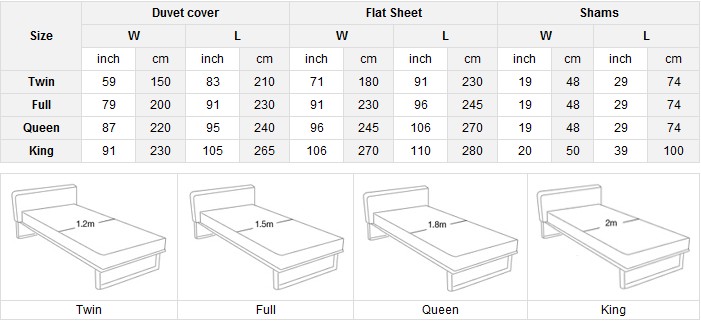4 Pieces Damask Duvet Cover Bedding Sets, All for Enjoyment!
Material: Satin
Crafts: Jacquard
Origin: NanTong, China
Unit Packing: 1 Set / PVC Bag
Care Instruction: Gentle Mashine Wash in Low Temperature, Do Not Bleach, Do Not Dry Clean, Washed Size Change 2%-3%
Product Dimensions
4 Pieces: 1pc Duvet Cover, 2pc Pillowcases, 1pc Loose-Fit Bottom Sheet
Full/Queen Size:
Duvet Cover: 200*230cm (79"*91")
Pillowcase: 48*74cm (18"*29")
Loose-Fit Bottom Sheet: 230*250cm (91"*99")
Queen/King Size:
Duvet Cover: 220*240cm (87"*95")
Pillowcase: 48*74cm (18"*29")
Loose-Fit Bottom Sheet: 250*270cm (99"*107")
Standard Size Chart

Damask is a weaving technique which originated in China during the Han Dynasty (200 BC), wherever it was used for producing vibrant, precious silk fabrics. The actual technique spread from the Orient via the actual Silk Road as well as Damascus in Syria became the actual centre of the damask weaving technique. In the centre Ages, the actual technique appeared in Southern Europe as well as moved northwards, getting a new centre in Haarlem, Holland. This is when the actual Georg Jensen family members encountered the weaving technique and contributed it returning to Denmark.
The actual damask weaving technique is characterised by thick, fine-threaded textiles. The pain relief pattern with matt and glossy areas is made by the alternating dominance connected with weft as well as warp. Damask is a distinctive woven design that looks to be floral or thriving. It is often compared to the classic fleur-de-lis shape. The same pattern is repeated in rows as well as columns, and it is typically visible on both sides of a fabric. Higher end damask fabrics are reversible, using the colors opposite on each part. For example , one side might appear as a white design on a black background, but when you turn it over it reveals that same pattern but with the style in black on a white background. The setting fabric is smooth, while the woven pattern is slightly raised.






